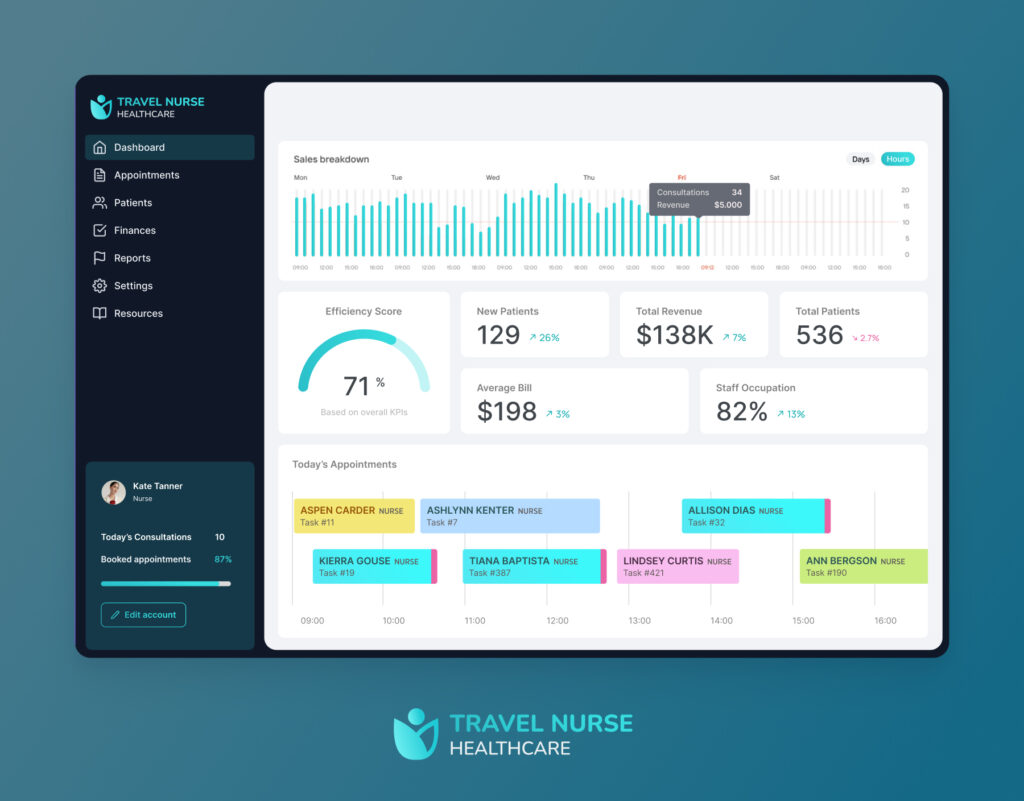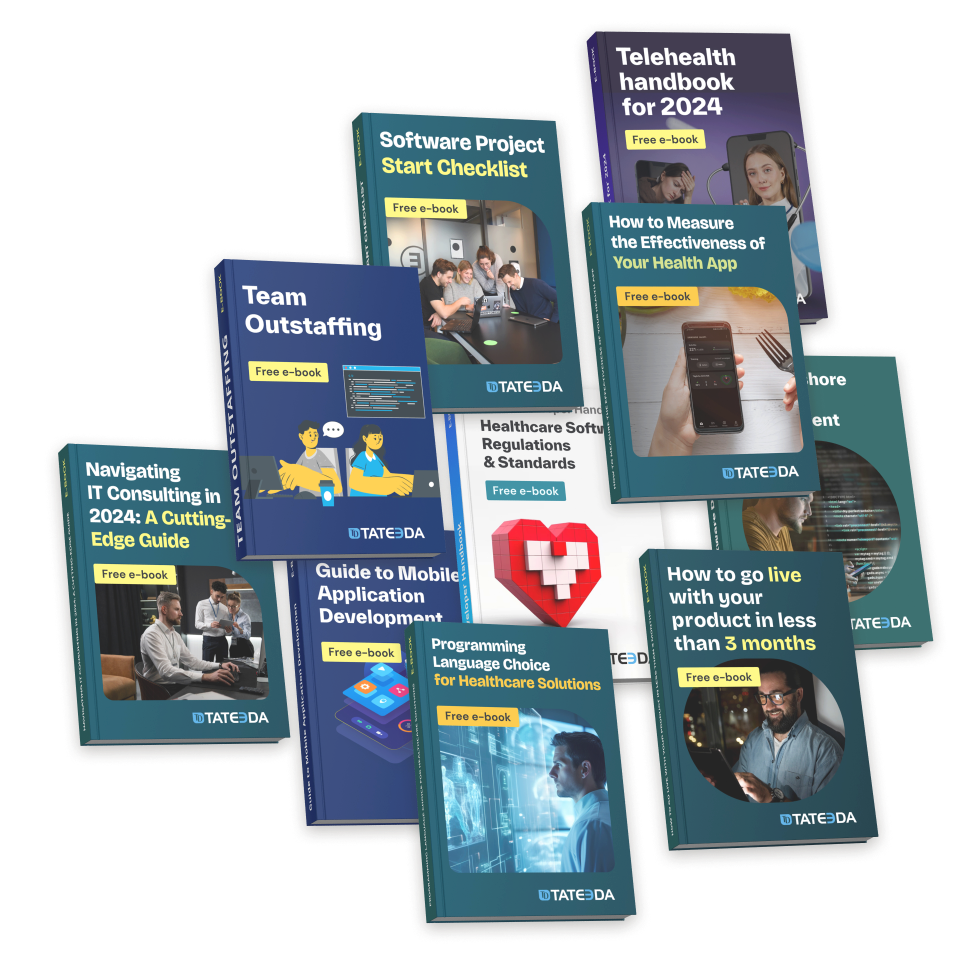How Inefficient Healthcare Staffing Hurts Your Facility (And What You Can Do About It)

Ever since dawn, the ED charge nurse had juggled half a dozen calls: Mary calling in sick, a late-arriving surgeon, and an unplanned surge of flu cases. By mid-morning, she was buried under spreadsheets and sticky notes, trying to cover shifts while keeping patient care on track.
This all-too-familiar scenario illustrates the everyday healthcare staffing challenges faced by hospitals and agencies across the country.
In this article, you’ll learn about:
- How custom healthcare staffing software development can automate critical workflows and free your team from costly inefficiencies and manual scheduling headaches
- Proven strategies to tackle common healthcare staffing challenges before they escalate into crises and heavy financial losses
- The real-world impact of poor staffing in healthcare on your budget, patient satisfaction, and regulatory standing, along with the specific software functions that help solve these problems.
Behind these moments of crisis lie deeper issues. Growing retirements drain experience, medical staff shortage fatigue fuels burnout, and educational pipelines can’t keep pace with demand.
When manual processes and paper forms govern your roster, every last-minute swap or credential check becomes another opportunity for staffing errors in medical facilities—and another hit to your bottom line.
Modern health technology trends offer a way forward. By embracing smart workforce management challenges in healthcare tools, you can automate schedules, verify credentials in seconds, and forecast staffing needs with confidence. Consider these essential capabilities:
- Automated shift-demand forecasting that predicts patient census spikes
- Self-service portals empowering staff to swap or pick up shifts
- Real-time credential checks against state boards and CAQH
- AI-driven alerts for fatigue, compliance lapses, and coverage gaps
- Integrated analytics dashboards consolidate time, attendance, and costs.
Below is a summary of the most common healthcare staffing management issues, the financial toll they impose, and the negative impacts if left unaddressed:
| Issue | Estimated Annual Loss | Assumptions | Negative Effects |
| Overtime premiums | $ 600,000 / year | 10 extra RN shifts/week × $ 1,200 OT rate × 52 weeks | Burnout, higher turnover, and runaway labor costs |
| Agency and contract labor markups | $ 1,296,000 / year | 30 agency shifts/month × $1 800 premium × 12 months | Margin erosion and dependency on external providers |
| Compliance fines & credentialing delays | $ 100,000 / year | 5 infractions (missed renewals or OT violations) × $ 20,000 each | Regulatory penalties and interrupted care delivery |
| Canceled procedures & lost revenue | $ 4,800,000 / year | 2 OR days cancelled/month × $ 200,000 lost revenue × 12 | Patient dissatisfaction and reputational damage |
| Readmission & error-related expenses | $ 3,000,000 / year | 200 preventable readmissions × $ 15,000 average cost | Higher malpractice claims and lower quality scores |
| Administrative overhead | $ 129,600 / year | 300 HR hours/month × $60/hour × 12 months | Diverted resources and stalled strategic initiatives |

Table of Contents
1. Rising Overtime Fees
Among healthcare staffing challenges, unfilled shifts force team members into overtime at 1.5× to 2× their usual pay, sometimes adding an extra $1,200 per shift. Those surprise bills can blow through your budget fast: ten backfilled shifts each week cost around $12,000. That patchwork approach creates a burnout loop—tired staff leave, leaving more gaps to fill. This all-too-common medical staffing problem shines a light on the real cost of inefficient staffing in hospitals and puts extra strain on your healthcare workforce management.
“Take a 200-bed community hospital that needs ten extra RN shifts each week to cover absences. At an average overtime rate of $1,200 per shift, that facility racks up an additional $12,000 every week (nearly $50,000 a month) just to keep beds open. At the same time, that money could have funded two full-time hires, improving the quality of care instead of draining budgets.”
— Slava K., TATEEDA’s CEO
How can software help cut costly overtime?
Healthcare staffing challenges, such as sudden patient surges and unplanned absences, drive up the cost of inefficient staffing in hospitals. By deploying a custom AI-driven healthcare scheduling system within a cloud-based staffing platform, you gain demand forecasting powered by machine-learning models that analyze census trends and absence history. Key features include:
- Predictive staffing algorithms that flag shortfalls days in advance
- Instant alerts via email, SMS, or in-app notifications for coverage gaps
- Mobile and web self-service shift-swap tools that empower staff
- Payroll integration that updates work-hour records immediately upon approval.
These capabilities can make your healthcare workforce management healthier, capping overtime expenses and preserving both your budget and your team’s well-being.
2. Agency Premiums Soaring
Dependence on travel nurses and staffing agencies to fill last-minute openings carries steep premiums, often two to three times higher than your in-house cost. These staffing errors in medical facilities not only bloat payroll but also make your organization vulnerable to rate hikes and agency shortages.
For example, a regional clinic averaging 30 agency nurse shifts a month at $1,800 each incurs $54,000 in extra pay. Over a year, that’s more than half a million dollars spent simply plugging holes—money that could instead support training programs, equipment upgrades, or patient-care initiatives.
How can software reduce reliance on expensive agency labor?
Facing skyrocketing agency premiums, you need smarter tools to fill open shifts. Modern healthcare staffing solutions give your internal team first crack at every opening before you dial the agency, tackling common healthcare workforce management issues head-on. Key features can include:
- Availability dashboard that shows who’s free, certified, and up-to-date on credentials
- Skill-and-certification tagging so you can filter clinicians by expertise and seniority
- An automated matching engine that weighs preferences, certifications, and past performance
- Push notifications to nurses’ phones or pagers when a suitable shift pops up
- Vendor management APIs that kick in only when your internal pool can’t cover a slot.
Behind the scenes, a cloud-based scheduling engine polls your talent registry every minute, runs predictive fill algorithms based on patient census forecasts, and syncs with time-tracking and credentialing modules via secure REST APIs. That way, your team stays engaged, quality stays high, and your contract labor premiums stay low.
Are You Ready to Solve Medical Staffing Problems?
Since 2013, our team has helped reduce the impact of poor staffing in healthcare with tailored software solutions.
3. Burnout-Driven Turnover Costs
Chronic understaffing causes burnout: nearly seven in ten nurses report feeling burned out most days, and one in five plans to retire within five years. This leads to high turnover, triggering expensive recruitment, onboarding, and training cycles, classic healthcare staffing management issues.
Replacing a single RN often costs up to $50,000 in hiring fees, orientation time, and lost productivity. If just five experienced nurses quit in a year, you face a quarter-million-dollar recruiting bill, not counting the hidden cost of inexperienced staff covering shifts in the meantime.
How can software improve workforce planning and cut burnout?
Cloud-based healthcare staffing software can tackle two big hurdles at once: fatigue and flawed schedules, showing you exactly how to improve healthcare workforce planning while avoiding staffing errors in medical facilities. Key features include:
- Automated rest-compliance checks that enforce break schedules
- Cumulative-hours tracking with alerts for at-risk clinicians
- Fair shift-rotation engine that balances nights, weekends, and days off
- Real-time fatigue-risk dashboards for managers
- Smooth custom software integration with payroll and scheduling modules.
Under the hood, a predictive engine ingests time logs, census data, and credential statuses to forecast staffing gaps and suggest optimal shift swaps. By fixing nurse scheduling inefficiencies, this healthcare staffing risks and solutions approach keeps your team rested, experienced clinicians on board, and your rostering running like clockwork.

4. Lost Revenue from Canceled Services
Understaffing often forces hospitals to cancel elective procedures or close specialty clinics, directly hitting your bottom line. The impact of poor staffing in healthcare can cost hundreds of thousands per day in foregone revenue, and frustrate patients on waiting lists.
“A midsize hospital that cancels just two operating-room days a month at an average revenue of $200,000 per OR day loses $400,000 each month. Over a year, that adds up to $4.8 million in missed income, which is far more than the cost of adding a handful of full-time staff.”
— Andrew G., TATEEDA’s Senior Software Architect
How can software prevent revenue losses from canceled procedures?
Healthcare staffing challenges, especially last-minute shortages, can force a hospital to cancel elective surgeries, costing upwards of $200,000 per OR day. This is a clear example of the impact of poor staffing in healthcare, where empty beds and idle ORs hit both your bottom line and patient trust. Key tools to optimize healthcare staffing include:
- Real-time shift-demand forecasting powered by ML on admission and census data
- Auto-reservation of staff in high-value departments like surgery and ICU
- Automated activation of standby pools when coverage dips below thresholds
- Cross-facility float-pool matching to fill gaps without agency hires
- Push notifications for credential renewals, preventing last-minute disqualifications.
By deploying a predictive healthcare scheduling system within a cloud-based healthcare staffing software suite, you tackle workforce management challenges in healthcare head-on, keeping critical services online and eliminating revenue losses before they happen.
5. Compliance Penalties and Fines
Manual tracking of licenses, certifications, and work-hour limits creates gaps in oversight. Missed renewals or overtime violations can result in fines up to $20,000 per incident, typical of staffing errors in medical facilities that lack centralized credential management.
“One regional health network faced a $60,000 penalty after three clinicians worked unauthorized overtime due to outdated schedules. That fine could have paid for an entire shift-planning analyst for a year.”
— Slava K., TATEEDA’s CEO
How can software ensure you stay compliant and avoid fines?
Healthcare staffing challenges like missed license renewals or untracked work hours can trigger fines up to $20,000 a violation. By embedding a credentialing and compliance module into your cloud-based healthcare staffing software, you gain an unalterable, time-stamped audit trail of every renewal date, license status, and hours log. Key features include:
- Automated reminders for upcoming license and certification expirations
- One-click status checks against primary sources (CAQH, NPDB) via secure APIs
- Encrypted, append-only logs that meet Joint Commission and CMS standards
- Role-based dashboards showing compliance gaps in real time
- Cloud integration in healthcare HR with your EHR and payroll systems.
This healthcare staffing software solution eliminates manual tracking, stops credential lapses before they occur, and shields your organization from costly sanctions.
6. Dropping Patient Satisfaction
When staff are thinly stretched, wait times lengthen and patient interactions feel rushed, driving down satisfaction scores. As scores fall, Medicare and insurance reimbursements can drop by up to 2 percent, translating into six-figure annual losses for many hospitals.
For example, a community hospital saw its HCAHPS score slip by 12 points in one quarter, triggering a $150,000 cut in annual reimbursements. Patients cited delayed call-bell responses and hurried discharge instructions—both symptoms of poor staffing.
How can software help uphold patient satisfaction?
Poor staffing levels are a leading contributor to long wait times and rushed interactions, which are a clear impact of poor staffing in healthcare that dents patient trust and your bottom line. Modern cloud-based healthcare staffing software tackles these healthcare workforce management challenges by giving you real-time visibility and the tools to optimize healthcare staffing around the clock. Key features include:
- Live patient-to-staff ratio dashboards that highlight units running thin
- Predictive staffing alerts powered by census and admission forecasts
- Smart reassignments that shift available clinicians into high-need areas
- Self-service portals for non-clinical staff to balance admin tasks
- Integrated patient feedback loops that surface satisfaction trends immediately.
By weaving these capabilities into a unified healthcare scheduling system, you not only reduce wait times but also boost HCAHPS scores and protect critical reimbursement levels. This proactive approach turns staffing data into happier patients and a healthier facility.
7. Error and Readmission Expenses
Fatigued or unfamiliar clinicians make more documentation mistakes and clinical errors. Preventable readmissions, averaging $15,000 each, and malpractice claims of $75,000 per incident, quickly add up—part of the impact of poor staffing in healthcare. One hospital recorded 200 preventable readmissions in a year, costing $3 million in extra stays and treatments. Nursing shortages and unscheduled float pool coverage were cited as primary factors.
How can software minimize clinical errors and readmissions?
Modern hospital staffing software uses AI-driven checks to match clinicians’ qualifications and experience with each shift’s needs, tackling core medical staffing problems and reducing staffing errors in medical facilities. Key features include:
- Skill-mix validation that ensures the right blend of RN, LPN, and tech on every unit
- Automated alerts when a schedule falls below safe staffing thresholds
- Integration with patient acuity data so high-risk areas receive additional support
- Real-time dashboards showing potential risk zones before they impact care.
By embedding these safeguards into your healthcare staffing solutions, you create a proactive shield against errors and keep readmissions—and their hefty bills—well under control.
8. Administrative Overhead Drain
Managing paper-based schedules, manual approvals, and credential files consumes hundreds of staff hours each month—classic healthcare staffing management issues that hide a $10,000 + monthly overhead for a mid-sized facility.
“In one network, HR staff spent 300 hours per month on scheduling and credential tracking, over $18,000 in labor costs at $60/hour. Meanwhile, slow approval chains led to delayed hires and open-shift premiums.”
— Andrew G., TATEEDA’s Senior Software Architect
How can software eliminate tedious administrative tasks?
Every month, HR teams lose 300 hours to manual scheduling, credential checks, and paperwork—time better spent on patient care. Cloud-based healthcare staffing software tackles these healthcare staffing challenges head-on by swapping repetitive tasks for automated workflows and self-service portals (similar to custom patient portal solutions). Key capabilities include:
- Self-service shift swap and leave request portals that cut approval chains to one click
- Robotic Process Automation (RPA) bots that intake, verify, and file credential documents
- Automated timesheet collection and validation tied directly into payroll systems
- Role-based dashboards that highlight pending approvals and bottlenecks.
This workforce planning approach slashes those 300 hours down to 50, so you can focus on strategy, not spreadsheets. Learn how to improve healthcare workforce planning by reclaiming admin time for initiatives that truly move patient care forward.

Case Study: Travel Nurse Healthcare Boosts Efficiency with Custom Healthcare Staffing Software
When Travel Nurse Healthcare, a leading US agency, struggled under the weight of last-minute absences, surprise overtime, and soaring agency premiums, they faced the harsh impact of poor staffing in healthcare firsthand. Their coordinators spent hours on manual rosters, credential checks, and phone calls, exposing critical workforce management challenges in healthcare and creating costly staffing errors in medical facilities.
Partnering with TATEEDA, they invested in a custom healthcare staffing software development process that automated core workflows and reclaimed hundreds of staff hours each month. Key deliverables included:
- Predictive Shift-Demand Forecasting, powered by machine learning, to anticipate census surges and avoid unplanned overtime
- Self-Service Scheduling Portal enabling nurses to swap or pick up shifts instantly, driving engagement and reducing coordination overhead
- Automated Credentialing Engine integrating CAQH and state-board APIs for real-time license status and audit-ready logs
- Fatigue-Risk Alerts that track cumulative hours and enforce rest-compliance rules to curb burnout
- Integrated Analytics Dashboard consolidates time, attendance, and cost data for transparent healthcare staffing management issues oversight.

Within three months of go-live, Travel Nurse Healthcare saw a 75% drop in overtime spend, a 60% reduction in agency labor premiums, and a 90% fill-rate for critical shifts. By tackling their most urgent healthcare staffing challenges with custom healthcare staffing software development, they eliminated billing surprises, safeguarded compliance, and elevated patient care across every assignment.
Ready to solve your own staffing headaches? Learn how to improve healthcare workforce planning and lock in reliable coverage with a custom solution.
Contact us to explore healthcare staffing solutions built for agencies like yours.








